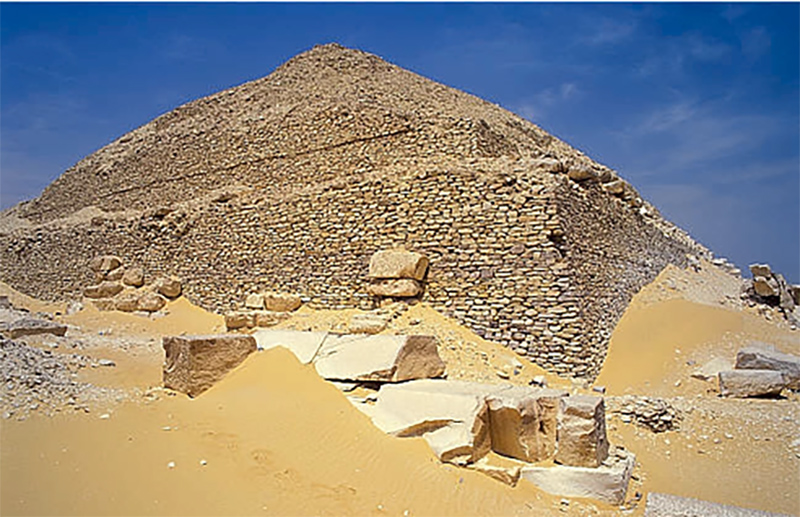
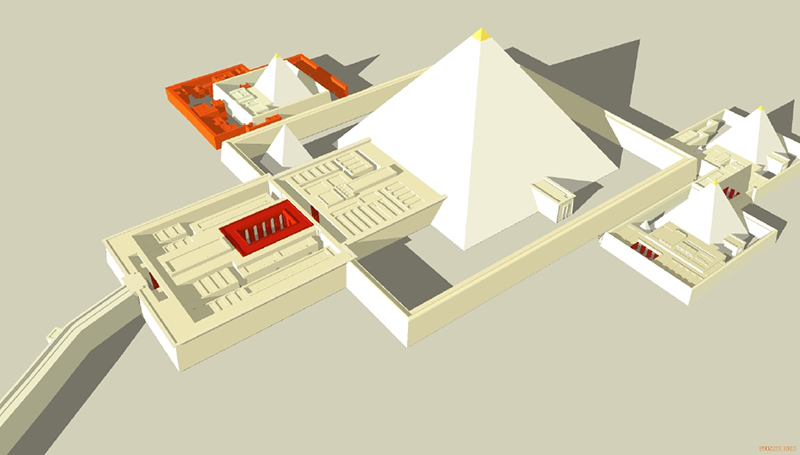
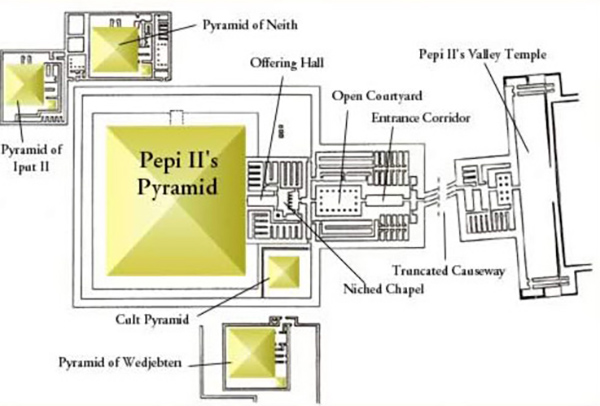



The Pyramid of Pepi II was the tomb of Pharaoh Pepi II, located in southern Saqqara, to the northwest of the Mastabat al-Fir'aun. It was the final full pyramid complex to be built in Ancient Egypt. Long used as a quarry, the pyramid was excavated for the first time by Gaston Maspero in 1881. Its ruins were studied in exhaustive detail by Gustave Jequier, who was able to reconstruct the funerary complex and the texts on the walls of the funerary chamber in the course of his excavation campaigns from 1932-1935. Since 1996, thorough investigations of the pyramid and its surroundings have been being carried out by the Mission archeologique fran¨aise de Saqq‰ra
The complex consists of the main pyramid, a Ka pyramid, three queen's pyramids, a valley temple and a mortuary temple, linked by a four hundred metre long covered causeway, running through the desert from the Nile to the pyramid.
The valley temple is unique for this type of structure. Located on a large quay, extending more than a hundred and fifty metres from north to south, it dominated a large harbor which once was linked to Memphis by a canal. It could be entered by two side ramps, which led to a sort of terrace, bounded by the temple facade on three sides, stretching the entire length of the quay and ending in two wings at the northern and southern ends, which had stairways built into them.
It is difficult to reconstruct the appearance of this facade because the whole structure is ruined and only the bottom few layers of stone remain. Some traces of a colonnade have been discovered, which probably indicate a long, high wall, lightly inclined at the sides, resting on two piers at the two ends of the harbour, which would have formed the heart of a pyramid town reaching all the way to the suburbs of Memphis.
The wall at the back of the terrace contained a single doorway which opened onto a large hall, with a ceiling supported by eight columns, with a series of four magazines on the south side. At the western end of the hall, there was a second hall surrounded by two further rows of magazines and a small corridor on the northern side leading to a staircase which allowed access to the temple's roof. Finally, a third hall, on the same eastŠwest axis as the other two, led into the causeway, which rain in a southwesterly direction all the way to the mortuary temple by the pyramid.
In the ruins of this structure Gustave Jequier discovered caskets with Pepi II's name and lids showing the king accompanied by gods who offer him the ankh, symbol of eternal life, or carry out parts of the coronation ritual. These items were clearly part of the cultic equipment of the temple.
The mortuary temple consists of an entrance space which is more than sixty metres wide on an eastŠwest axis. From the end of the causeyway to the pyramid enclosure, one passed through an entrance hall flanked by two small annexes, then a large corridor opening onto a massive ceremonial court. The court had a peristyle, consisting of eighteen quartzite pillars. The side of each of the pillars which faced the centre of the court was engraved with a representation of the king accompanied by a god and inscribed with royal protocol. The magazines flanking this courtyard could only be accessed by a long corridor at the eastern end of the courtyard. At the other end of the courtyard was a doorway leading through the wall of the pyramid enclosure into the inner part of the mortuary temple. There there were five cult chapels with all the annexes necessary for their operation, and finally one came to the hall which contained the false door of Pepi II. To the south of this inner part of the mortuary temple, within the pyramid enclosure, was the ka-pyramid which was a dozen metres high.
Many fragments of the temple decoration have been recovered, allowing the reconstruction of the iconographic program, which showed the king receiving processions of people bringing offerings and showing him leading hunts and battles against the enemies of Egypt in the presence of the high officials of the kingdom. Some representations of these enemies on round bosses have been discovered. Figures on their knees with their hands tied behind their backs were presumably dominated by statues of the king which would have been scattered in niches throughout the temple. The depiction of these enemies is identical to that found in the mortuary temple of Sahure. There are also several depictions of the god Min and of the heb-sed festival.
The superstructure was once composed of six steps, forming a true pyramid. Each of the steps was formed of a masonry formwork of local limestone held in place with mortar, filled with rubble of the same limestone. Each step was built on top of the one below. Once the six steps were completed, a second layer of limestone masonry filled in the gaps between the steps. This was itself covered by a cladding of fine limestone from Tura, which was partially preserved around the base of the pyramid.
The pyramid was a little over fifty two metres high and each side was over seventy eight metres long. This corresponds to a hundred Egyptian cubits in height and a hundred and fifty cubits in length. On the north side of the pyramid there was a chapel which sheltered the entrance to the underground funerary chamber.
The excavations and studies of the pyramid have revealed that the construction quality was inconsistent and this caused serious structural issues, especially concerning the cladding, which threatened to crack at the base, break off, and collapse under its own extraordinary weight. The ancient architects responded to this issue by building a wall all the way around the pyramid, embedded in the paving of the enclosure, under the cladding. This wall was built from carefully dressed waste stone, which gave it enough solidity for its role as a "buttress". In the process of building this wall, they destroyed the north chapel, reusing the stone in the wall, which indicates that the buttress wall was built as a result of events subsequent to Pepi II's funeral.
It is because of this reuse of the stone that it has been possible to recover all the reliefs which initially covered the walls of the north chapel. Their iconographic programme was reconstructed by Gustave Jˇquier. On the east and west walls there were large figures of the king seated on his throne in front of tables of offerings, filled by a series of servants advancing from the north wall. Framing the doorway on the north wall were images of the arrival of people with offerings, especially scenes of butchers. The south wall was dominated by a false door, with a procession of gods. This decoration is similar to that of the north chapels of other pyramid complexes, known only from small traces; the complete decoration of Pepi II's north chapel allows Egyptologists to contextualise those traces.
The substructure is similar to that of the Pyramid of Djedkare-Isesi, which was the model for all subsequent pyramids. A passageway descending from a point on the north face of the pyramid which was originally protected by the north chapel runs a little over twenty metres. It is blocked by four granite blocks at the entrance and leads to an entrance hall with a ceiling painted with five rows of white stars on a black background, oriented to the west. Then there is a horizontal corridor, itself blocked off by three granite blocks. The walls of this corridor are decorated with Pyramid Texts. It is followed by a funerary antechamber on an eastŠwest access and located under the very centre of the pyramid. The burial chambers were by a vault of eighteen massive stone blocks, arranged in chevrons. The ceiling of this vault was painted blue and covered with golden stars. On the eastern side of the antechamber, a doorway led to the serdab of the pyramid which has been completely destroyed.
The burial chamber, whose walls are covered in pyramid texts, is 3.15 metres wide and nearly eight metres long (7.79 metres at the north end, 7.91 metres at the south end). The western wall of the chamber is painted with the facade of a palace.
The sarcophagus is made out of greywacke; it is nearly three metres long, around 1.3 metres wide and 1.2 metres high. All four sides are engraved with hieroglyphs listing the complete royal titulary pf Pepi II. The sarcophagus is a fine piece of work, but shows some traces of incompleteness with respect to the inscription, which also retains marks of preparatory guide lines and shows no signs of the gilding which was usual for a royal sarcophagus in this period. The lid of the sarcophagus is also made of greywacke and is more obviously unfinished; in places it was never smoothed and there are no traces of inscriptions. Some fragments of an alabaster chest for the canopic jars were found with the sarcophagus. The lid of this chest was also found, but is cut from a granite block - another sign of difficulty in completing the burial goods which were apparently completed in a hurry.
In addition, the decoration of the funerary chambers seems to have been abandoned abruptly, which further supports the conclusion that the structure was built in a hurry. This seems difficult to square with the long reign attributed to Pepi II. Throughout the monument, Egyptologists have revealed traces of uneven and incomplete work, as if construction had been repeatedly halted, such that the burial goods and burial chambers had to be completed in a hurry on the death of the king.
Like all the royal pyramid complexes, Pepi II's pyramid sat at the heart of a necropolis in which his family members and court officials built their own tombs, in order to follow their king into the afterlife. As part of this necropolis, three Queen's pyramids have been identified, all given independent cult complexes. These miniature pyramid complexes have all the elements necessary for the funerary cult of royal wives at the end of the 6th dynasty. They are the:
Pyramid of Wedjebten to the southeast of Pepi II's pyramid complex,
Pyramid of Neith, to the northwest of the royal pyramid complex
Pyramid of Iput II, also to the northwest.
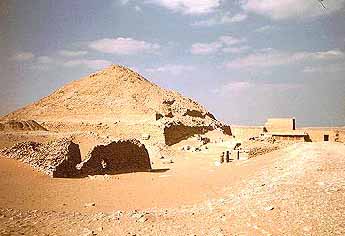
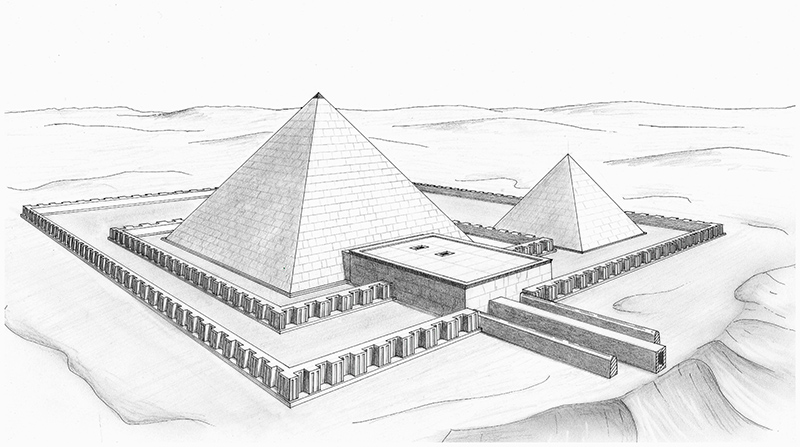
The pyramid in the background is that of Pepi II.
In the foreground, the ruins are of Udjebten's pyramid.
The pyramid complex of Udjebten was located on the southeast corner of Pepi's enclosure wall. We believe that she was a daughter of Pepi I, and wife of Pepi II.
The mortuary temple of Udjebten was very simple, with an entrance on the north side. The temple contained the basic elements, with a vestibule, an open courtyard, but without pillars, and interestingly a chapel like room that seems to have only had two statue niches. The walls of this niche room are decorated with reliefs of the queen before a goddess and others depicting the slaughtering of cattle. Another small fragment of reliefs show the base of a throne, apparently similar to a scene in the chapel of Neith's mortuary temple. Of course there was also an offering hall. Like the pyramid itself, the mortuary temple was completely ruined, with the only openly visible evidence of its existence being the offering table of alabaster which bears an inscription with a funerary formula and the queen's name. Other fragments bear an inscription with a decree protecting the queen's cult.
Of Pepi II's queens' pyramids, Udjebten's was probably the most ruined when discovered by Jequier. Even the core structure was barely discernible. However, with luck he did find a few fragmentary inscriptions from the mortuary temple that proved the pyramidion was sheathed in the finest gold.
Below ground, in the substructure of the pyramid, the ground plan does not differ much from that of the pyramids of Pepi II's other queens, though there was no serdab adjoining the antechamber. The walls of the of the burial chamber and possibly the corridors were again covered in pyramid text, of which 84 fragments were recovered. This represented about one tenth of the actual inscriptions.
The main pyramid complex of Udjebten has an enclosure wall, but a second wall encloses both the main complex and a secondary complex of structures. They resemble houses and storage facilities, and inscriptions here refer to a family line of priests. Each of her beneficiaries had a chamber here, and a small courtyard in which they set up proxy symbols of their real households and tombs. These beneficiaries apparently shared in her funerary estate, much as she shared in the estate of her husband, Pepi II.
Neith was Pepi II's half sister and cousin. She was the daughter of Pepi I and Ankenesmerire I (Ankhesenpepi I). Ankenesmerire I's younger sister named Ankenesmerire II (Ankhesenpepi II) was Pepi II's mother, and so it is very likely that she was older then Pepi II.
Her tomb is located at the northwest corner of Pepi II's complex, and is the finest and oldest of these queens' pyramids. Her complex was surrounded by its own enclosure wall.
The entrance of this pyramid's mortuary temple was at the southeast corner of the perimeter wall. It was flanked by two small limestone obelisks bearing the queen's name and title. As with most pyramids of this period, there are inner and outer sections to the mortuary temple. A vestibule was directly within the entrance and has been named by Egyptologists, the lions room.
Reliefs found in this room depicted lions carrying ornamental sashes. As with most king's pyramids, there was also an open, pillared courtyard, along with five storage annexes completing the outer part of the mortuary temple. On the walls of the courtyard were found scenes with offerings and the queen. The inner sanctuary consisted of a small chapel and offering hall.
The chapel, as was also customary for queens mortuary temples, contained only three niches as opposed to that of most king's chapels which contain five.
South of the chapel, the offering hall began in the middle of the east wall of the pyramid. It of course had a false door, so that the deceased could partake of her symbolic meals, traveling from the pyramid into this room and back again. In front of the false door is a stepped alter that still sands in its original location. The walls of the offering hall were adorned with presentation scenes.
Like the other queens, Neith's complex had its own cult pyramid which was about 5.25 meters (18 feet) square, but nevertheless had a miniature passage leading to a small, rectangular chamber. The chamber, when found, was covered in shards of pottery vessels.
The pyramid itself had a three step core. Most queens' pyramids were barely larger then the small cult pyramids associated with the main royal pyramids. It was built of similar materials as Pepi II's, using local limestone for the core, and fine white limestone for the casing. As customary at this time, the interior of the pyramid was entered from the pavement of the pyramid's open courtyard.
This entrance was located in the middle of the pyramid's north side, and there was an entrance chapel with scenes depicting offering bearers. On the south wall of the chapel was a granite false door that sealed the entrance corridor. The entrance corridor initially descended, but a pink granite barrier was placed at the point where it became level.
However, prior to arriving at the burial chamber, there was another barrier. The burial chamber itself was located on the pyramids vertical axis, and had a flat ceiling with astronomical decorations (stars on a dark background). This room was oriented east-west. As in only one other queen's pyramid before it, there were pyramid texts decorating its walls.
However, only three walls revealed pyramid text, while the fourth wall, west of the sarcophagus, had a symbolic palace facade. Her mummy was not found in the burial chamber, but fragments of alabaster and diorite vessels were. Her empty red granite sarcophagus remains in the chamber, along with her canopic chest of the same material. East of the burial chamber there was a small room we refer to as a serdab.
Jequier, one of the archeologists who excavated this pyramid made a unique discovery at the southeast corner of the pyramid. here, he found a number of wooden model ships lying in a shallow pit. Their variety and state of preservation is unparalleled.
Ipwet, or Iput II, is was one of Pepi II's less attested queens. The principal queen of Teti, who was Pepi II's grandfather, was also named Iput (I), so she may very well have been of royal blood 1. However, her title did not refer to her as "King's mother". Apparently, prior to this dynasty, pyramids were not built for queens who bore no pharaohs.Her pyramid complex is located on the southwest corner of Neith's complex.
Her mortuary temple was laid out like the letter L. Like that of Neith's the entrance of her mortuary was flanked by two small obelisks with inscriptions of the name and title of Ipwet. This gateway was made of pink granite. It is difficult to assess the layout of the mortuary temple, but on the east side of the pyramid stood the offering hall, which had a reddish quartzite false door that has been mostly preserved. Otherwise, it had the expected elements, including a vestibule, open courtyard, we presume a small niche room, an offering hall and storage annexes.
This pyramid is now almost completely ruined, but it does not differ much from that of Neith's. Significantly however, it was smaller, with poorer furnishings. Egyptologists assume that her sarcophagus was made of pink granite.
The most interesting aspect of this pyramid has nothing to do with its construction, or Queen Ipwet, but rather a granite sarcophagus that Jequier discovered in the westernmost storeroom of the mortuary temple. We believe it might have belonged to a Queen Ankenesmerire IV (Ankhesenpepi IV), though considerable doubt remains. She would have been another of Pepi II's consorts and may have been the mother of an insignificant king of the 8th Dynasty named Neferkare Nebi. Her relationship to the other queens by the same name is unknown. She probably outlived Pepi II and even married again. An inscription on a stele at Abydos would seem to indicated that she became the wife of a Prince Iuu.
But what is informative to us is the clearly poor form of burial that illustrates the material and social decline of the royal family after Pepi II's death.
Perhaps even more important were inscriptions found on both sides of the basalt sarcophagus lid that resembling the Palermo stone.. At the time of the discovery in 1932, these inscriptions were unreadable, but modern photographic enhancement by French Egyptologists Michel Baud and Vasil Dobrev allowed a new, and sensational discovery. It contained part of the royal annals of the 6th Dynasty, with considerable new information.
The debate over aspects of this discovery will continue for some time. However, the context of the inscription seems to lend support to the rule of a King Userkare near the beginning of the 6th Dynasty, perhaps are a period of around four years.
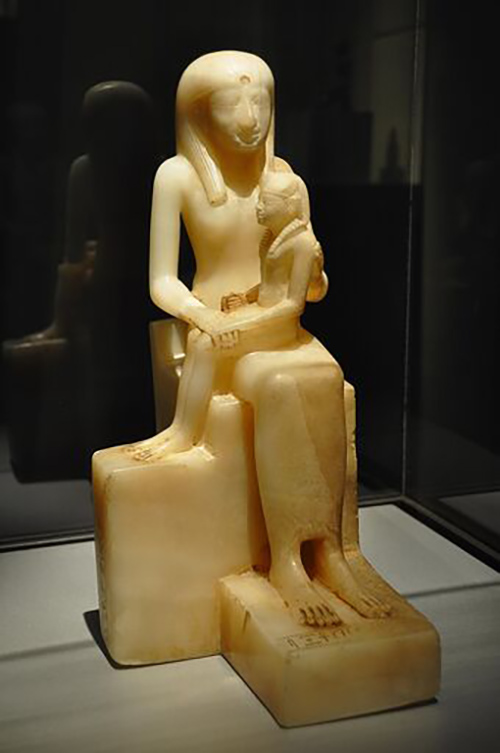
Pepi II
SACRED PLACES AND TEACHINGS INDEX